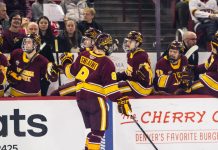The ECAC has its share of great forwards: Mike Harder at Colgate, Martin St. Louis and Eric Perrin at Vermont, Todd White at Clarkson, Paul DiFrancesco at St. Lawrence, Ryan Smart at Cornell, Henry Higdon at Harvard, and others.
There are also a number of quality defensemen: Mikko Ollila at Clarkson, Jeremiah McCarthy at Harvard, Steve Wilson at Cornell, Jan Kloboucek at Vermont, along with others.
But at the goaltender position, there remain questions. For years coaches have preached that a great goaltender can help a team reach new levels. Nowhere was this more evident than on the big stage last year, in the NHL and the World Cup of Hockey.
The Florida Panthers were able to reach the Stanley Cup Finals based largely on the strength of their goaltender, John Vanbiesbrouck. The Panthers were not a great skating or scoring team, but the Beezer raised the level of their play.
Speaking of which, how about Mike Richter? Team USA’s netminder played a crucial role at the World Cup; while the Americans were deep offensively, Richter shined in the final series against Canada, who pelted the goal mercilessly. Without Richter, the USA doesn’t win the World Cup. Period.
The same idea can be applied to the ECAC. It is clear that goaltending can turn an otherwise-average team into a contender, or take a team with talent up front back to the middle of the pack.
The correlation between goaltending and the top of the standings is clearer than ever this season in the ECAC. Let’s examine the 12 conference teams (in reverse predicted order of finish), and assess their goaltending.
The last time Yale made a run at the top of the standings was with second-team All-ECAC goalie Todd Sullivan. Dan Choquette and Alex Westlund are now the netminders, combining for a goals-against average (GAA) of 4.59 last year. There is no question that these are competent goalies, but not of the caliber of Sullivan, who allowed well under four goals per game.
Union, in their short Division I history, has not had a strong goaltending tradition. But things seem to be changing on that front. They now have Leeor Shtrom (3.09 GAA) in the net, and because of him Union is a dangerous team. The Dutchmen were picked next-to-last, but if they find any kind of offense, they could move up several spots — because their netminder can play with the best.
Princeton’s recent rise was with James Konte in goal. In fact, one might argue that he led them to the ECAC Championship game in 1995. Konte has since graduated, and Erasmo Saltarelli assumes the role of starting goaltender. For Princeton to have success, Saltarelli must impress.
With Brown, we have the same story of solid but not spectacular. Brian Audette and Jeff Holowaty are back, and get the job done, but are not guys that can steal the show like Geoff Finch could.
RPI is another team looking for a presence in net. With a great tradition of goaltending from folks like Kevin Constantine, Darren Puppa, Neil Little, and Mike Tamburro, RPI fans have grown accustomed to counting on their goaltenders. Now two freshmen, Scott Prekaski and Joel Laing, are fighting for the job, and no one knows what that will mean.
The Harvard Crimson have been blessed with quality tandems in goal such as Chuckie Hughes and Allain Roy, Aaron Israel and Tripp Tracy. But what about now? Peter Zakowich and J.R. Prestifillipo are the candidates. As of yet they are untested, but so were the others once. If they can make the adjustment, Harvard could be in for one nice ride.
For Dartmouth, Scott Baker and Ben Heller return with a combined GAA of 4.59 and with a stronger D in front of them this season. While these two haven’t proven it yet, they will likely steal some games, and if they do, Dartmouth will be up there in the standings.
Now we get into the elite class of goalies in the ECAC, starting with Cornell. Jason Elliot is a one man gang; he backstopped the Big Red to the ECAC Championship last year, and brings back a GAA of 2.35 and a .923 save percentage. Can he do it again? If so, Cornell is in for another sweet season.
Clint Owen is the man for St. Lawrence, and he is a good one. He’s got the tools necessary to put St. Lawrence over the top. However, he will have to sit out the first half of this season because of an undisclosed violation of team rules. That leaves Jon Bracco minding the store. Though Bracco is solid, St. Lawrence will take a step back with him in the net. Life will be good in Canton when Owen gets back, but until then, what will the Saints do without him?
Dan Brenzavich leads the Colgate Red Raiders. He is overshadowed by others in his class, but Brenzavich is a winner in his own right. However, he has yet to prove he can win the big games, and until he does, how far Colgate can go remains a mystery.
Dan Murphy is Clarkson’s workhorse, a second-team All-ECAC pick for the second year running. He plays almost every game for the Golden Knights, and is as solid as they come (2.70 GAA, .912 SV%). The Golden Knights usually have the goalies; this year is no different.
What else can you say about Tim Thomas? He has done the job since he first stepped onto the ice in Burlington. A 2.34 GAA is right on his career numbers, and now that the nation knows him better, what he can do, everyone should see what the fanfare is about.
Generally, then, the second-division teams do not have a strong presence in net. Conversely, the teams at the top have the elite ones, as is usually the case.
Some of the teams in the middle of the pack could make significant moves one way or another depending on how their goaltending questions pan out. Dartmouth could finish as high as fifth or sixth, but could drop much lower if their keepers don’t perform.
On the other end of the spectrum, there are teams like RPI and Harvard, who could finish better than predicted if their goaltenders come off solidly. Harvard is in a slightly different position; they are well-regarded, but if their tandem fails to get the job done the Crimson could be in serious trouble.
Basically, the top spots in the conference could come down to which goalie can put his team on his back. The ECAC is typical in that regard — strength between the pipes is a must. Clearly some teams are set up nicely in this regard, while others will struggle. As the season goes on, we’ll find out a lot about the league by how the goaltenders play.


